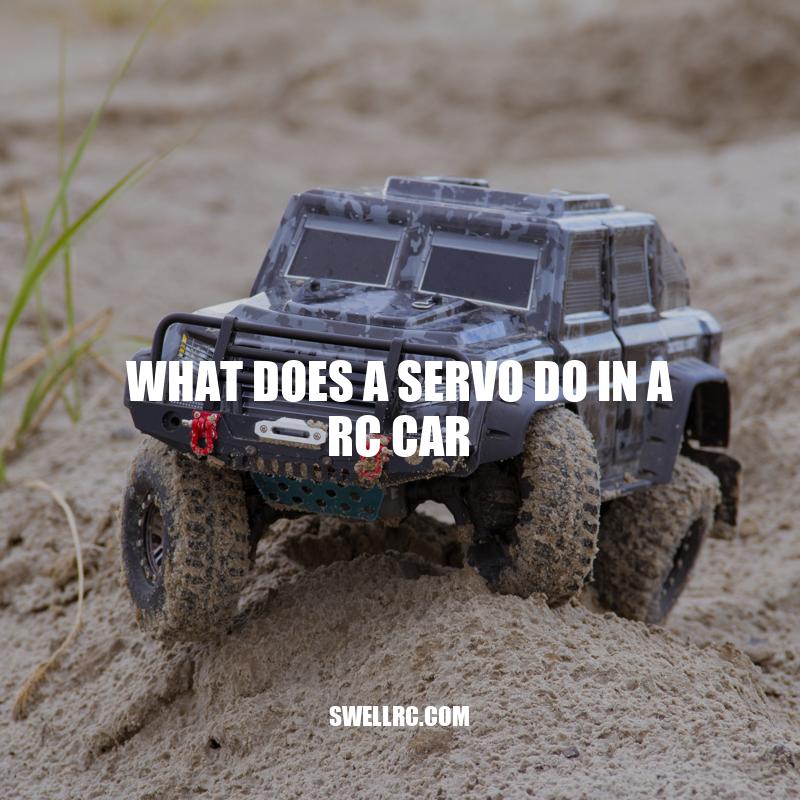Understanding Servos in RC Cars: Function, Types, Placement and Maintenance
Radio-controlled cars, or RC cars, are popular among hobbyists of all ages. There is something exciting about controlling a miniature car with a remote control and making it maneuver through various terrains, whether on a paved road or an off-road track. One crucial component that enables RC car owners to enjoy complete control over their vehicles is the servo. A servo is an electromechanical device that converts electrical pulses into mechanical motion, and it is responsible for controlling the direction of the wheels or the throttle in a remote-controlled car. In simple terms, the servo takes instructions from the receiver, which accesses the remote control, and transfers them to the steering of an RC car. The importance of the servo component in RC cars cannot be overstated, as without it, the operator would have no control over the vehicle. In this article, we will discuss what a servo does in an RC car, the different types of servos, their placement, maintenance and troubleshooting tips, and upgrades, among other things.
Servos and their function
A servo is a critical component in an RC car, without which a vehicle would be nothing more than an expensive and stationary model. RC cars use a servo to control several functions, including the steering system and throttle management. Here are some essential facts about servos and their function:
- A servo consists of three main components: a motor, a gearbox, and a control circuit board.
- The motor is responsible for converting electrical energy into rotational output, while the gearbox converts rotational motion to linear motion to actuate the arm of the servo.
- Servos use pulse signals to generate torque and position the arm in the desired location, meaning that they can provide high-precision, smooth, and consistent motion.
- Typically, servo operation requires a 5-volt power supply and control signals in the range of +/- 90 degrees.
However, not all servos are made the same, and some may have unique features and capabilities that set them apart. Stick around to learn more about the different types of servos that you can use in your RC car to enhance its maneuverability and performance. If you’re looking for top-rated servos, check out the options available on websites like Amazon, HobbyKing, or Tower Hobbies.
What does a servo do in a RC car?
A servo is a small device that helps to control the steering and throttle of an RC car. Here’s what it does:
- The servo takes input signals from the car’s receiver and translates them into physical movement.
- It controls the direction and speed of the wheels to help the car turn and navigate obstacles.
- Without a properly functioning servo, an RC car would not be able to navigate or steer on its own.
If you’re looking for more information on RC cars or need to replace a servo, check out websites like Horizon Hobby or RC Planet for products and resources.
Types of servos
Servos come in various types, each with its unique characteristics and advantages. Here are some of the most common types of servos used in RC cars:
| Type | Description | Advantages | Disadvantages |
|---|---|---|---|
| Standard Servos | The most basic type of servo that uses brushed motors and analog control signals. | Inexpensive, simple to use and operate, and widely available. | Less precise and slower than other types, poor accuracy, and resolution. |
| Brushless Servos | Uses brushless motors and digital control signals for precise and faster operation. | Higher accuracy and speed, smoother performance, and better efficiency. | Pricier than standard servos, may require specialized hardware or software to operate. |
| Digital Servos | Uses digital control signals to provide precise and accurate positioning of the servo arm. | Very high accuracy and resolution, smooth operation, and fast response. | More expensive than other types of servos, may require specialized hardware, and consume more power. |
Interestingly, some servos use metal gears that can provide greater torque and durability than plastic gears, which are found in most servos. Metal gear servos are ideal for heavy-duty applications or RC cars that will be driven on tough terrain. If you’re interested in purchasing servos, RC-related websites like amainhobbies.com, RCplanet.com and horizonhobby.com offer an extensive selection of servos that are compatible with your RC car model.
What servo to use for RC car?
When it comes to choosing a servo for your RC car, there are a few things to consider:
- Size: Make sure you choose a servo that fits the dimensions of your RC car.
- Speed: The speed of the servo is measured in seconds per 60 degrees. Choose a speed that suits your needs.
- Torque: The torque of the servo is measured in kg/cm. Choose a torque that can handle the weight of your RC car.
- Brand: Some popular brands for servos include Futaba, Hitec, and Spektrum.
If you’re unsure which servo to choose, consult with the manufacturer of your RC car or do some research on RC forums and websites like RC Planet or Tower Hobbies.
Placement of Servos in RC cars
Where you place the servo in your RC car is crucial as it affects the car’s handling and performance. Here are some important points to consider:
Steering Servo Placement
– The steering servo should be placed as close as possible to the front wheels to provide optimal control of the vehicle’s steering.
– Any slack or looseness in the linkage system connecting the servo to the steering knuckles should be eliminated to avoid steering response delays.
Throttle Servo Placement
– The throttle servo is usually placed at the rear end of the car, close to the engine compartment, where it can pull on the carburetor’s linkage.
– Ensure that the throttle servo’s output arm is precisely aligned with the carburetor’s full-open position to avoid unnecessary strain on the engine.
Proper servo placement is crucial for optimal car performance and handling. Improper servo installation can result in sluggish performance or even accidents, so care must be taken when installing and setting up the servos. If you’re unsure about proper servo placement, there are plenty of RC-related forums and websites that can offer advice and tips on optimizing your RC car setup.
What is the purpose of a servo in an RC car?
A servo is a small motor used in remote control cars to control steering and throttle. It is connected to the receiver and uses a series of gears to convert the electrical signal from the transmitter into the rotational movement needed for the wheels. The purpose of the servo is to provide precise and responsive control of the car’s movements. Without a servo, an RC car would not be able to turn or accelerate properly.
If you’re looking to upgrade your RC car’s performance, consider investing in a high-quality servo. Popular online hobbyist stores such as Horizon Hobby, Amain Hobbies, and Tower Hobbies offer a wide selection of servos for various types of RC cars.
Maintenance and Troubleshooting
Servos are important components that require proper maintenance and occasional troubleshooting. Here are some tips to keep your servos running smoothly:
Maintenance
- Regularly check the servo gears for signs of wear, as worn gears can lead to damage or failure.
- Keep the servo cases clean and free of dirt and debris.
- Lubricate the gears and moving parts using a suitable lubricant.
Troubleshooting
- If you experience slow or sluggish servo response, it’s likely a problem with the servo’s gears. Clean the gears and check for wear.
- If the servos are jittery or vibrating, make a note of the voltage coming into the receiver. Also, check that the servo arm is not overdriven, causing unnecessary drag on the servo motor.
- If the servos are not responding to your commands, double-check your wiring connections between the receiver and the servo.
It’s always a good idea to double-check your servo components before each RC car run to ensure that they are working correctly. If you’re not sure how to troubleshoot servo-related issues, consult RC-related forums or websites where you can find advice from qualified experts. Additionally, some websites offer high-quality replacement servo components to upgrade and improve your RC car’s handling and performance.
How do you maintain a servo motor?
– Regularly clean the motor and its surroundings to prevent dust and dirt accumulation that could damage the motor.
– Lubricate the motor bearings to ensure smooth operation.
– Check and replace worn or damaged gears or belts.
– Monitor the motor’s performance and vibrations to detect any potential issues and address them promptly.
– Consult the motor’s manual or contact the manufacturer for specific maintenance guidelines.
For more information and resources on servo motors and their maintenance, you can check out websites like automationdirect.com or products like the Kollmorgen AKM servo motors.
Upgrades and Modifications
If you’re seeking to improve your RC car’s handling and performance, upgrading and modifying your servo components is one way to go about it. Here are some suggested modifications you can make:
Better Quality Servo
– Upgrade to a higher-quality servo – Brushless, waterproof, and digital servos are designed to handle more challenging driving conditions such as wet terrain or high speed.
– Select a servo that has the correct torque and speed ratings that matches your RC car’s needs. More torque indicates more power, while more speed provides faster responses.
Stronger Servo Material
– Choose a high-quality servo made from better materials such as Titanium, Aluminum, or Carbon fiber. These designs are stronger and more durable, allowing the servo to withstand harsh environments and prevent transmission failure.
Servo Arm Upgrade
– Replace your RC car’s stock servo arm with a high-strength aluminum or titanium arm to reduce flex and increase power transfer from the servo to the car’s wheels.
There is a wide range of online resources and product websites where you can find valuable information about replacement servos, upgrades, and modifications. You can also join RC-related forums and communities to get tips and recommendations from other enthusiasts on what has worked well for them.
How can I make my servo stronger?
Here are a few ways to increase the strength of your servo:
- Use a higher voltage battery to provide more power to the servo.
- Upgrade to a higher torque rated servo.
- Reduce the load on the servo by decreasing the weight or friction of the mechanism it is controlling.
- Adjust the endpoints on your transmitter to limit the range of motion of your servo.
Products such as high-performance servos or reinforced servo gears are also available to increase the strength and durability of your servo. It is important to note that increasing the strength of the servo will also increase power consumption and may require adjustments to your overall system setup.
Conclusion
In conclusion, the servo is an essential component in the functionality and performance of an RC car. Its job is to translate the transmitter’s steering or throttle signals into a mechanical motion that moves the car’s wheels accordingly. When choosing a servo, it is important to consider your RC car’s specific needs and determine which servo type best matches that need. Always ensure that your servo component is installed correctly, maintained in good condition, and troubleshooted promptly should any issues arise.
By following these basic principles, you can enjoy a safe and fun driving experience. As you become more involved in the world of RC cars, you’ll become more comfortable with modifications to improve the performance of your vehicle. There are numerous resources available online to help you in your journey, from online forums to product websites. With the right knowledge, your RC car can provide days, even years, of fun and excitement.



